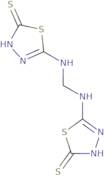Información del producto
- 1,3,4-Thiadiazole-2(3H)-thione, 5,5'-(methylenediimino)bis-
- 1,3,4-Thiadiazole-2-thiol, 5,5'-(methylenediimino)bis-
- 5,5'-(Methanediyldiimino)bis(1,3,4-thiadiazole-2-thiol)
- 5,5'-(Methylenediimino)bis(1,3,4-thiadiazole-2-thiol)
- 5,5′-(Methylenediimino)bis[1,3,4-thiadiazole-2(3H)-thione]
- 79319-85-0
- Chuan Hua 018
- Mbamt
- N,N′-Methylenebis(2-amino-5-sulfhydryl-1,3,4-thiadiazole)
- T5Nmysj Cus Em1M- Et5Nmysj Cus
- Ver más sinónimos
- T5Nn Dsj Csh Em1M- Ct5Nn Dsj Esh
- Thrill 20WP
- Yeqingshuang
Bismerthiazol is a complex compound that was originally developed as an antimicrobial agent. It has been shown to be effective against resistant mutant strains of bacteria in wastewater treatment, and also has terminal residues (less than 0.5 ppm) that are not harmful to the environment. Bismerthiazol inhibits bacterial growth by interfering with the synthesis of bacterial cell walls and disrupting the enzyme activity required for cell wall biosynthesis. This interaction interrupts the polymerase chain reaction and prevents DNA replication, leading to bacterial cell death. The synergic effect of bismerthiazol with hydrochloric acid provides an antibacterial efficacy that is 20 times greater than either agent alone. It is toxic at high concentrations in vitro, but is non-toxic at low concentrations in vivo. There are no acute toxicities observed in vivo or in vitro.





